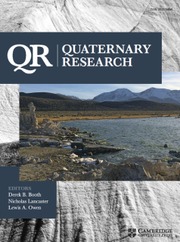Article contents
Geophysical sediment properties of a late Pleistocene loess–paleosol sequence, Chenarli, northeastern Iran
Published online by Cambridge University Press: 11 April 2023
Abstract
We present stratigraphic, magnetic, diffuse reflectance spectrophotometric analyses, and chronologic data for the Chenarli loess–paleosol sequence in northeastern Iran. Eight loess units (LU) are identified, described, and constrained in time based on relative stratigraphy and luminescence dating from >130 ± 9.1 ka to ~9.8 ± 0.7 ka. Our data indicate that pedogenic magnetite/maghemite formation gives rise to magnetic enhancement in modern soil and paleosols. The top of LU 7 is demarcated by the well-developed last interglacial soil in which magnetic depletion occurred. We infer that magnetic depletion in this paleosol was produced by reducing conditions in a seasonally waterlogged soil during a warm and wet phase within Marine Isotope Stage (MIS) 5e. Units LU 6 to 1 record several episodes of dust accumulation and soil formation during the last glacial and Holocene. Increased dust accumulation rates occurred during middle-late MIS 3 and lasted into the late MIS 2, with a peak during the last glacial maximum (LU 2). These findings could be applicable to understanding magnetic enhancement/dissolution mechanism in the loess–paleosol sequences in study area. We infer paleoenvironmental changes in northeastern Iran relative to northern Iran, Eurasia, and China.
Keywords
Information
- Type
- Research Article
- Information
- Copyright
- Copyright © University of Washington. Published by Cambridge University Press, 2023
References
REFERENCES
- 2
- Cited by


